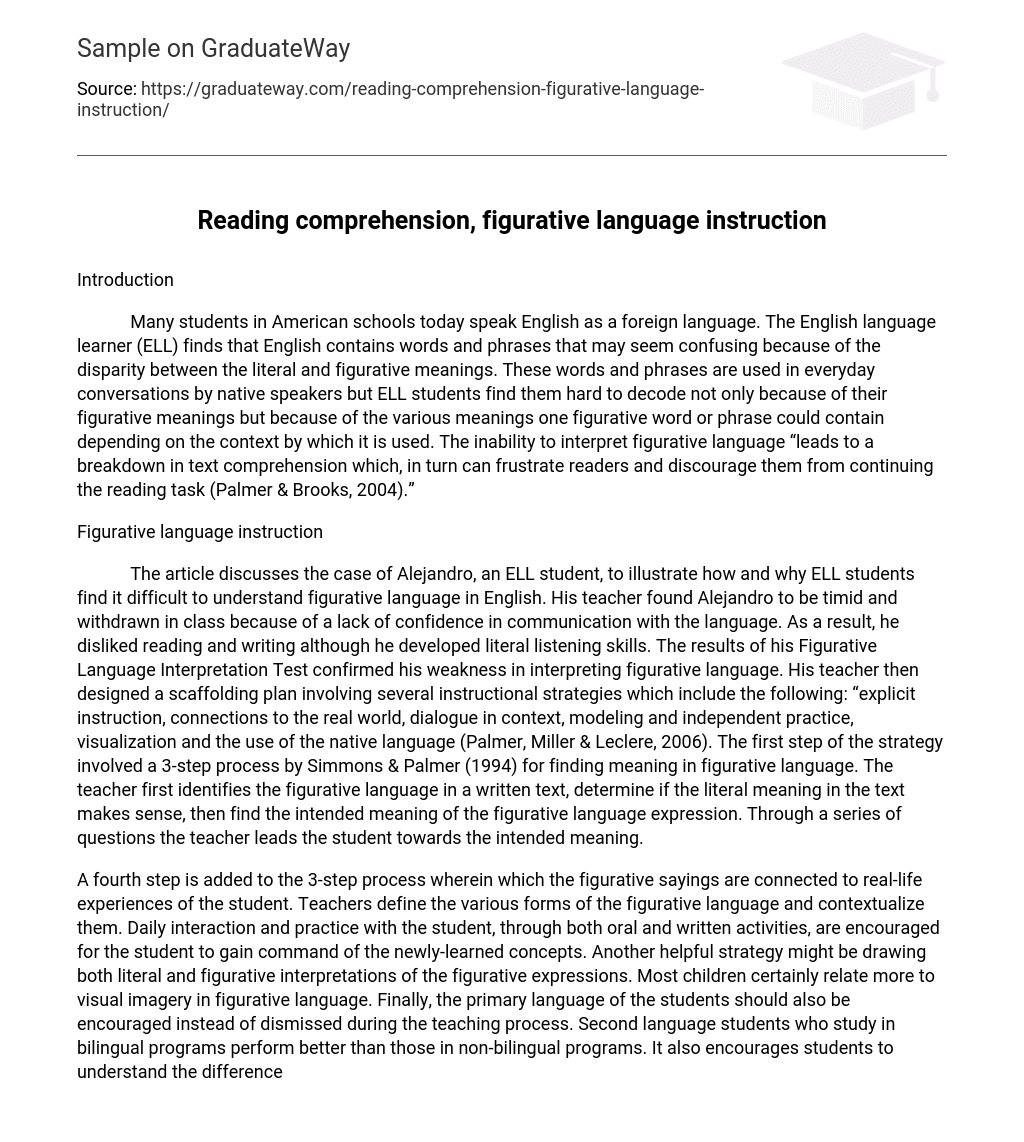Introduction
Many students in American schools today speak English as a foreign language. The English language learner (ELL) finds that English contains words and phrases that may seem confusing because of the disparity between the literal and figurative meanings. These words and phrases are used in everyday conversations by native speakers but ELL students find them hard to decode not only because of their figurative meanings but because of the various meanings one figurative word or phrase could contain depending on the context by which it is used. The inability to interpret figurative language “leads to a breakdown in text comprehension which, in turn can frustrate readers and discourage them from continuing the reading task (Palmer & Brooks, 2004).”
Figurative language instruction
The article discusses the case of Alejandro, an ELL student, to illustrate how and why ELL students find it difficult to understand figurative language in English. His teacher found Alejandro to be timid and withdrawn in class because of a lack of confidence in communication with the language. As a result, he disliked reading and writing although he developed literal listening skills. The results of his Figurative Language Interpretation Test confirmed his weakness in interpreting figurative language. His teacher then designed a scaffolding plan involving several instructional strategies which include the following: “explicit instruction, connections to the real world, dialogue in context, modeling and independent practice, visualization and the use of the native language (Palmer, Miller & Leclere, 2006). The first step of the strategy involved a 3-step process by Simmons & Palmer (1994) for finding meaning in figurative language. The teacher first identifies the figurative language in a written text, determine if the literal meaning in the text makes sense, then find the intended meaning of the figurative language expression. Through a series of questions the teacher leads the student towards the intended meaning.
A fourth step is added to the 3-step process wherein which the figurative sayings are connected to real-life experiences of the student. Teachers define the various forms of the figurative language and contextualize them. Daily interaction and practice with the student, through both oral and written activities, are encouraged for the student to gain command of the newly-learned concepts. Another helpful strategy might be drawing both literal and figurative interpretations of the figurative expressions. Most children certainly relate more to visual imagery in figurative language. Finally, the primary language of the students should also be encouraged instead of dismissed during the teaching process. Second language students who study in bilingual programs perform better than those in non-bilingual programs. It also encourages students to understand the differences between their two languages, especially with regard to figurative language.
Conclusion
The strategies explained in the article look simple enough and can be practiced by any teacher handling classes with ELL students. They are practical and have been proven effective. The steps outlined in the article have actually been used by countless ELL teachers although some practices may have not been to the letter as defined by the authors. Palmer and her co-authors also defined the concepts clearly and labeled every step of the strategy so that it becomes an organized step by step program that can be adapted to ELL students in various American classrooms. I personally advocate the strategy for my own classroom.
The current educational curriculum encourages equal educational opportunities for all students throughout the country whatever their cultural and linguistic backgrounds. The extra effort to help those who grew up with English being merely a second language should, therefore, be given attention. Ultimately, the goal is not only to help ELL students to comprehend figurative language, but for them to overcome all other barriers towards understanding the English language.
References
Palmer, B.C., & Brooks, M.A. (2004). Reading until the cows come home: Figurative language and reading comprehension. Journal of Adolescent & Adult Literacy, 47, 370–379.
Palmer, B. C., Shackelford, V.S. Miller, S.C., & Leclere, J.T. (2007, January/December). Bridging two worlds: Reading comprehension, figurative language instruction, and the English language learner. Journal of Adolescent & Adult Literacy, 50 (4).
Simmons, J.S., & Palmer, B.C. (1994). Reading by doing: An introduction to effective reading (3rd ed.). Lincolnwood, IL: National Textbook.





